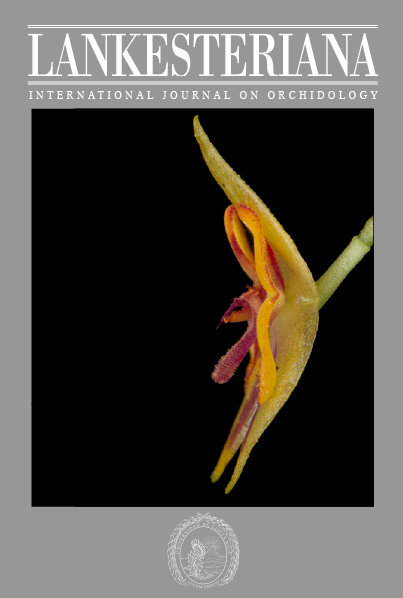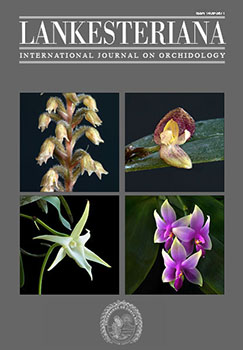<i>Lepanthes chalalensis</i> (Pleurothallidinae), a new species endemic to the Santander department in Colombia
DOI:
https://doi.org/10.15517/lank.v24i2.56321Palabras clave:
Cordillera Oriental, endémico, muestreo estandarizado, NeotrópicoResumen
Proponemos Lepanthes chalalensis como una nueva especie confinada al noreste de los Andes de Colombia. La nueva especie fue hallada en un muestreo de 341 parcelas aleatoriamente posicionadas a lo largo de la Cordillera Oriental, incluyendo hábitats transformados y naturales. Se proporcionan la descripción detallada,imágenes ilustrativas, discusiones ecológicas y un análisis del estado de conservación. La especie está altamente restringida geográficamente (en 2 de las 341 parcelas de muestreo) y tiene un tamaño de población bajo (26 individuos adultos). Aunque L. chalalensis muestra una similitud con L. velosa de Ecuador, puede distinguirse por el lóbulo inferior de los pétalos, que es ancho y presenta una cilios largos, las láminas del labelo, que están reducidas y presentan cilios rígidos, y la longitud del apéndice, que parece ser el doble de la longitud de las láminas del labelo. La especie debe considerarse una preocupación de conservación debido a su alta rareza.
Descargas
Citas
Acevedo, M. A., Beaudrot, L., Meléndez‐Ackerman, E. J. & Tremblay, R. L. (2020). Local extinction risk under climate change in a neotropical asymmetrically dispersed epiphyte. Journal of Ecology, 108(4), 1553–1564. https://doi.org/10.1111/1365-2745.13361
Averyanov, L. V., Pham Van The, Loc Phan Ke, Nguyen, H., Nguyen, T. V., Canh, C. X. & Nguyen, H. Q. (2014). Field survey of Pahiopedilum canhii: from discovery to extinction. Slipper Orchids FALL, 2014, 2–11.
BGCI. (2023). ThreatSearch online database. Botanic Gardens Conservation International. Richmond, UK. Retrieved from www.bgci.org/Threat_search.Php Accessed 20 August 2023.
Blanco, M. A. & Barboza, G. (2005). Pseudocopulatory pollination in Lepanthes (Orchidaceae: Pleurothallidinae) by fungus gnats. Annals of Botany, 95(5), 763–772. https://doi.org/10.1093/aob/mci090
Bogarín, D., Pérez-Escobar, O. A., Groenenberg, D., Holland, S. D., Karremans, A. P., Lemmon, E. M., Lemmon, A. R., Pupulin, F., Smets, E. & Gravendeel, B. (2018). Anchored hybrid enrichment generated nuclear, plastid and mitochondrial markers resolve the Lepanthes horrida (Orchidaceae: Pleurothallidinae) species complex. Molecular Phylogenetics and Evolution, 129, 27–47. https://doi.org/10.1016/j.ympev.2018.07.014
Brown, M. J. M., Bachman, S. P. & Nic Lughadha, E. (2023). Three in four undescribed plant species are threatened with extinction. New Phytologist, 240(4), 1340–1344. https://doi.org/10.1111/nph.19214
Ceballos, G., Ehrlich, P. R., Barnosky, A. D., García, A., Pringle, R. M. & Palmer, T. M. (2015). Accelerated modern human-induced species losses: Entering the sixth mass extinction. Science Advances, 1(5), e1400253. https://doi.org/10.1126/sciadv.1400253
Chase, M.W. & Peacor, D. (1987). Crystals of calcium oxalate hydrate on the perianth of Stelis Sw. Lindleyana, 2, 91–94.
Crain, B. J. & Tremblay, R. L. (2014). Do richness and rarity hotspots really matter for orchid conservation in light of anticipated habitat loss? Diversity and Distributions, 20(6), 652–662. https://doi.org/10.1111/ddi.12179
Emeterio-Lara, A., García-Franco, J. G., Hernández-Apolinar, M., Toledo-Hernández, V. H., Valencia-Díaz, S. & Flores-Palacios, A. (2021). Does extraction of orchids affect their population structure? Evidence from populations of Laelia autumnalis (Orchidaceae). Forest Ecology and Management, 480, 118667. https://doi.org/10.1016/j.foreco.2020.118667
Etter, A., Andrade, A., Saavedra, K., Amaya, P., Cortés, J. & Arévalo, P. (2021). Ecosistemas colombianos: amenazas y riesgos. Una aplicación de la Lista Roja de Ecosistemas a los ecosistemas terrestres continentales. Pontificia Universidad Javeriana y Conservación Internacional-Colombia.
Fernández, D. S., Tremblay, R. L., Ackerman, J. D., Rodríguez, E. & López, L. N. (2003). Reproductive potential, growth rate and light environment in Lepanthes rupestris Stimson. Lankesteriana, 7, 73–76.
Haddad, N. M., Brudvig, L. A., Clobert, J., Davies, K. F., González, A., Holt, R. D., Lovejoy, T. E., Sexton, J. O., Austin, M. P., Collins, C. D., Cook, W. M., Damschen, E. I., Ewers, R. M., Foster, B. L., Jenkins, C. N., King, A. J., Laurance, W. F., Levey, D. J., Margules, C. R., Melbourne, B. A., Nicholls, A. O., Orrock, J. L., Song, D.-X. & Townshend, J. R. (2015). Habitat fragmentation and its lasting impact on Earth’s ecosystems. Science Advances, 1(2). https://doi.org/10.1126/sciadv.1500052
Hinsley, A., de Boer, H. J., Fay, M. F., Gale, S. W., Gardiner, L. M., Gunasekara, R. S., Kumar, P., Masters, S., Metusala, D., Roberts, D. L., Veldman, S., Wong, S. & Phelps, J. (2018). A review of the trade in orchids and its implications for conservation. Botanical Journal of the Linnean Society, 186(4), 435–455. https://doi.org/10.1093/botlinnean/box083
IUCN. (2020). The IUCN Red List of threatened species v. 2019-3. Retrieved from https://www.iucnredlist.org.
Karremans, A. P., Moreno, J. S., Gil-Amaya, K., Gutiérrez Morales, N., Espinosa, F., Mesa, S., Restrepo, E., Rincón-González, M., Serna, A., Sierra-Ariza, M. & Vieira-Uribe, S. (2023). Colombian Orchidaceae: a catalogue of the Pleurothallidinae. Lankesteriana, 23(2), 181–400. https://doi.org/10.15517/lank.v23i2.56158
Karremans, A. P., Rojas-Alvarado, G., Bezerra-Silva, L. E., Flores-Rojas, J., Murillo-Murillo, J. M., Romero-Ceciliano, M. & Segura-Bermúdez, O. A. (2021). Nomenclatural notes in the Pleurothallidinae (Orchidaceae): Miscellaneous part II. Phytotaxa, 496(2), 134–146. https://doi.org/10.11646/phytotaxa.496.2.3
Kindlmann, P., Meléndez-Ackerman, E. J. & Tremblay, R. L. (2014). Disobedient epiphytes: colonization and extinction rates in a metapopulation of Lepanthes rupestris (Orchidaceae) contradict theoretical predictions based on patch connectivity. Botanical Journal of the Linnean Society, 175(4), 598–606. https://doi.org/10.1111/boj.12180
Luer, C. A. (1990). Icones Pleurothallidinarum. VII. Systematics of Platystele (Orchidaceae). Monographs in Systematic Botany from the Missouri Botanical Garden, 38, 1–132.
Luer, C. A. (1996). Icones Pleurothallidinarum. XIV. The genus Lepanthes, subgenus Lepanthes in Ecuador. Monographs in Systematic Botany from the Missouri Botanical Garden, 61(3), 1–255.
Luer, C. A. & Hirtz, A. C. (1987). New species of Lepanthes. Die Orchidee, 38(1), 38.
Luer, C. A. & Thoerle, L. (2012). Icones Pleurothallidinarum. XXXII. Lepanthes of Colombia (Orchidaceae). Monographs in Systematic Botany from the Missouri Botanical Garden, 123, 1–300.
Moreno, J. S., Sandoval-Arango, S., Palacio, R. D., Alzate, N. F., Rincón, M., Gil, K., Morales, N. G., Harding, P. & Hazzi, N. A. (2020). Distribution Models and Spatial Analyses Provide Robust Assessments of Conservation Status of Orchid Species in Colombia: The Case of Lephantes mucronata. Harvard Papers in Botany, 25(1), 111–121. https://doi.org/10.3100/hpib.v25iss1.2020.n14
Parra-Sánchez, E., Pérez-Escobar, O. A. & Edwards, D. P. (2023a). Neutral-based processes overrule niche-based processes in shaping tropical montane orchid communities across spatial scales. Journal of Ecology, 111(8), 1614–1628. https://doi.org/10.1111/1365-2745.14140
Parra-Sánchez, E., Restrepo, E., Alegria-Valencia, M., Moreno, J. S. & Galindo-Tarazona, R. (2023b). Lepanthes cordillerana (Orchidaceae) a new species and the landscape threats to its wild populations. Phytotaxa, 603(1), 69–80. https://doi.org/10.11646/phytotaxa.603.1.5
Parra-Sánchez, E., Vieira-Uribe, S. & Moreno, J. S. (2023c). new species of Lepanthes (Orchidaceae: Pleurothallidinae) to honour “Bachué”, the mythological mother of the indigenous Muisca people. Lankesteriana, 23(2), 127–137. https://doi.org/10.15517/lank.v23i2.54032
Pérez-Escobar, O. A., Chomicki, G., Condamine, F. L., Karremans, A. P., Bogarín, D., Matzke, N. J., Silvestro, D. & Antonelli, A. (2017). Recent origin and rapid speciation of Neotropical orchids in the world’s richest plant biodiversity hotspot. New Phytologist, 215(2), 891–905. https://doi.org/10.1111/nph.14629
QGIS. (2021). QGIS Geographic Information System. QGIS Association. Retrieved from QGIS.org
Rabinowitz, D. (1981). Seven forms of rarity. In H. Synge (Ed.), The biological aspects of rare plant conservation (pp. 205–217). John Wiley & Sons.
Romero-González, G.A. & Carnevali, G. (2000). Orquídeas de Venezuela [una Guía de Campo Ilustrada]. Caracas: Armitano Editores.
Stearn, W. T. (1992). Botanical Latin (4th ed.). Portland, USA: Timber Press
Tadono, T., Ishida, H., Oda, F., Naito, S., Minakawa, K. & Iwamoto, H. (2014). Precise Global DEM Generation by ALOS PRISM. ISPRS Annals of the Photogrammetry, Remote Sensing and Spatial Information Sciences, II–4, 71–76. https://doi.org/10.5194/isprsannals-II-4-71-2014
Travis, J. M. J. (2003). Climate change and habitat destruction: a deadly anthropogenic cocktail. Proceedings of the Royal Society of London. Series B: Biological Sciences, 270(1514), 467–473. https://doi.org/10.1098/rspb.2002.2246
Tremblay, R. L. (1997). Distribution and Dispersion Patterns of Individuals in Nine Species of Lepanthes (Orchidaceae). Biotropica, 29(1), 38–45.
Tremblay, R. L., Zimmerman, J. K., Lebrón, L., Bayman, P., Sastre, I., Axelrod, F. & Alers-García, J. (1998). Host specificity and low reproductive success in the rare endemic Puerto Rican orchid Lepanthes caritensis. Biological Conservation, 85(3), 297–304. https://doi.org/10.1016/S0006-3207(97)00163-8
Vancutsem, C., Achard, F., Pekel, J.-F., Vieilledent, G., Carboni, S., Simonetti, D., Gallego, J., Aragão, L. E. O. C. & Nasi, R. (2021). Long-term (1990–2019) monitoring of forest cover changes in the humid tropics. Science Advances, 7(10), 1–21. https://doi.org/10.1126/sciadv.abe1603
Wilson, A. M. & Jetz, W. (2016). Remotely Sensed High-Resolution Global Cloud Dynamics for Predicting Ecosystem and Biodiversity Distributions. PLOS Biology, 14(3), e1002415. https://doi.org/10.1371/journal.pbio.1002415
Zizka, A., Silvestro, D., Vitt, P. & Knight, T. M. (2021). Automated conservation assessment of the orchid family with deep learning. Conservation Biology, 35(3), 897–908. https://doi.org/10.1111/cobi.13616

Descargas
Publicado
Cómo citar
Número
Sección
Licencia
Derechos de autor 2024 Lankesteriana: International Journal on Orchidology

Esta obra está bajo una licencia internacional Creative Commons Reconocimiento-NoComercial-SinObraDerivada 3.0.
Conforme con las Políticas de Acceso Abierto promovidas por la Universidad de Costa Rica, los derechos de autor de todos los artículos publicados en Lankesteriana se encuentran bajo una licencia Creative Commons y pueden ser descargados gratuitamente. Los derechos de autor y de publicación pertenecen a la revista bajo la licencia CC BY-NC-ND 3.0 CR.
Before the publication of the materials submitted by the author(s) in LANKESTERIANA, the author(s) hereby assign all rights in the article to the Lankester Botanical Garden.




